Shingles Infection: Healthcare Standards and Fall Prevention Report
VerifiedAdded on 2023/01/03
|6
|1765
|100
Report
AI Summary
This report examines the case of Mrs. Smith, a 50-year-old woman admitted to the Emergency Department with shingles, a communicable infection characterized by painful rashes and blisters. The report identifies and discusses two key infection control principles, namely routine hygiene practices like handwashing and the use of protective equipment, and provides rationales for their implementation in Mrs. Smith's care to minimize infection transmission within the hospital setting. It then explores the National Safety and Quality Health Service Standard (NSQHS) for Comprehensive Care, explaining its relevance to Mrs. Smith's case, particularly in identifying and addressing her needs, and preventing any harm. Furthermore, the report addresses fall prevention strategies using the NSQHS standards, emphasizing the importance of mobility enhancement and environmental adjustments, and promoting patient awareness to prevent further injuries to Mrs. Smith during her hospital stay. The report concludes by highlighting the importance of patient-centered care and knowledge development to maintain patient safety.
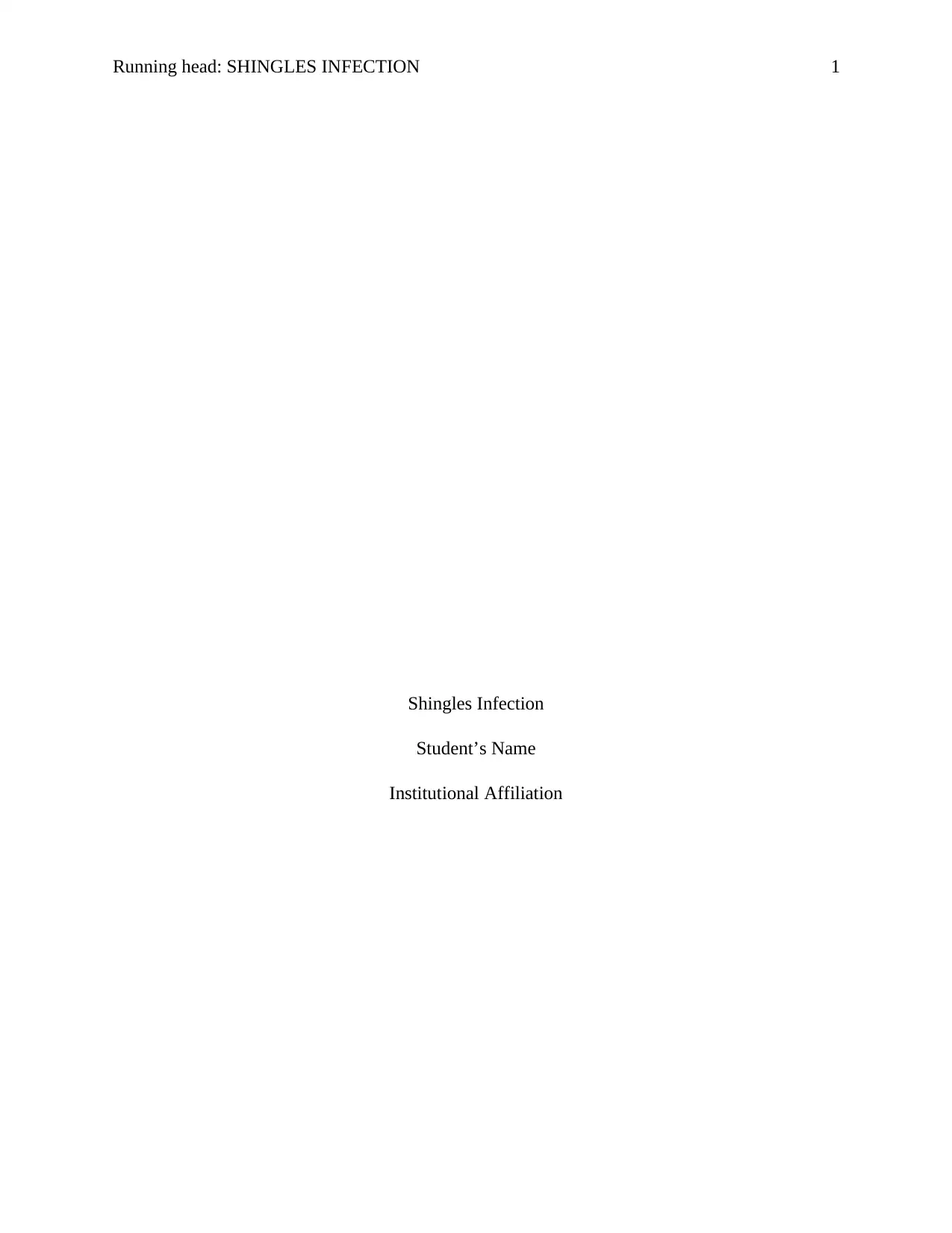
Running head: SHINGLES INFECTION 1
Shingles Infection
Student’s Name
Institutional Affiliation
Shingles Infection
Student’s Name
Institutional Affiliation
Paraphrase This Document
Need a fresh take? Get an instant paraphrase of this document with our AI Paraphraser
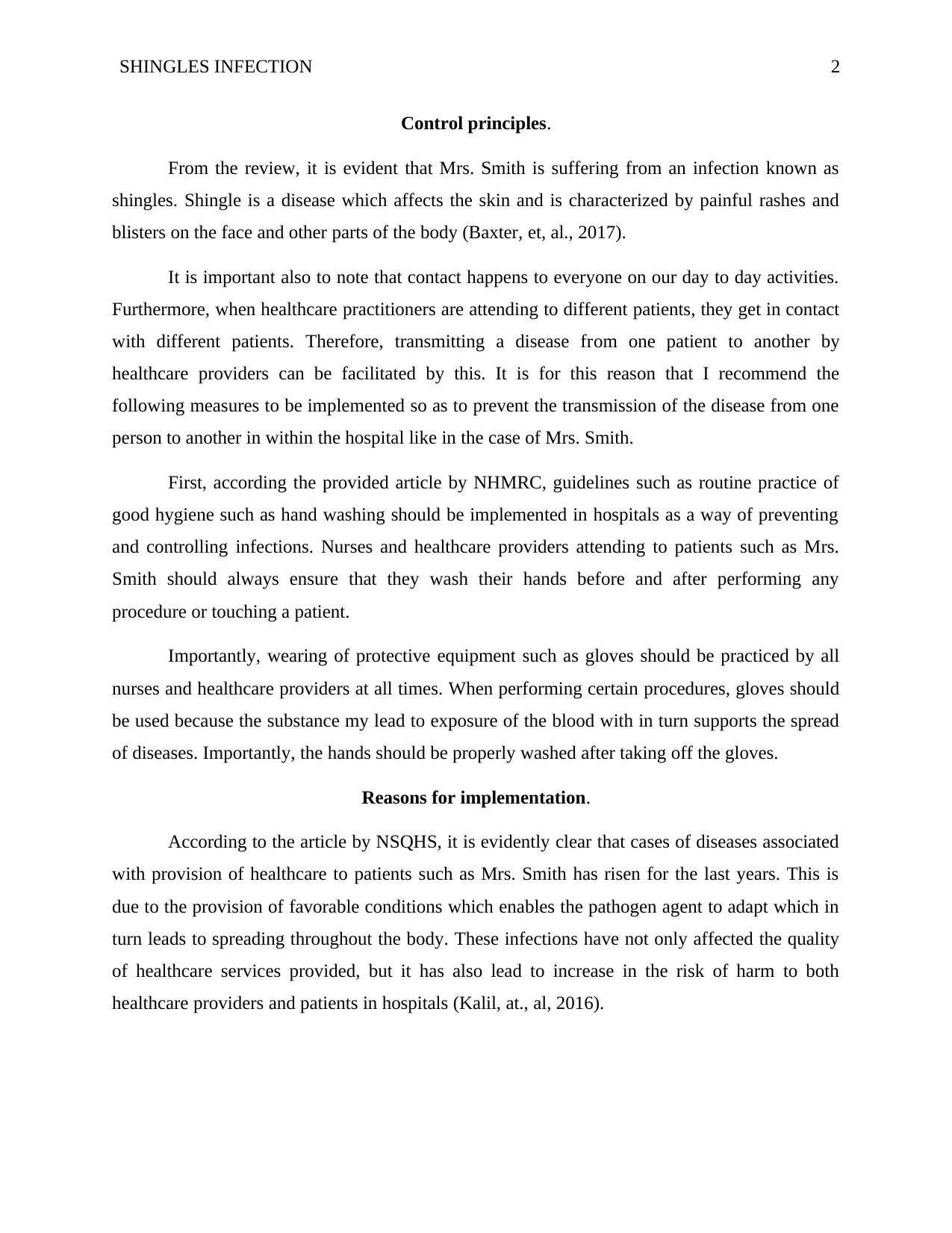
SHINGLES INFECTION 2
Control principles.
From the review, it is evident that Mrs. Smith is suffering from an infection known as
shingles. Shingle is a disease which affects the skin and is characterized by painful rashes and
blisters on the face and other parts of the body (Baxter, et, al., 2017).
It is important also to note that contact happens to everyone on our day to day activities.
Furthermore, when healthcare practitioners are attending to different patients, they get in contact
with different patients. Therefore, transmitting a disease from one patient to another by
healthcare providers can be facilitated by this. It is for this reason that I recommend the
following measures to be implemented so as to prevent the transmission of the disease from one
person to another in within the hospital like in the case of Mrs. Smith.
First, according the provided article by NHMRC, guidelines such as routine practice of
good hygiene such as hand washing should be implemented in hospitals as a way of preventing
and controlling infections. Nurses and healthcare providers attending to patients such as Mrs.
Smith should always ensure that they wash their hands before and after performing any
procedure or touching a patient.
Importantly, wearing of protective equipment such as gloves should be practiced by all
nurses and healthcare providers at all times. When performing certain procedures, gloves should
be used because the substance my lead to exposure of the blood with in turn supports the spread
of diseases. Importantly, the hands should be properly washed after taking off the gloves.
Reasons for implementation.
According to the article by NSQHS, it is evidently clear that cases of diseases associated
with provision of healthcare to patients such as Mrs. Smith has risen for the last years. This is
due to the provision of favorable conditions which enables the pathogen agent to adapt which in
turn leads to spreading throughout the body. These infections have not only affected the quality
of healthcare services provided, but it has also lead to increase in the risk of harm to both
healthcare providers and patients in hospitals (Kalil, at., al, 2016).
Control principles.
From the review, it is evident that Mrs. Smith is suffering from an infection known as
shingles. Shingle is a disease which affects the skin and is characterized by painful rashes and
blisters on the face and other parts of the body (Baxter, et, al., 2017).
It is important also to note that contact happens to everyone on our day to day activities.
Furthermore, when healthcare practitioners are attending to different patients, they get in contact
with different patients. Therefore, transmitting a disease from one patient to another by
healthcare providers can be facilitated by this. It is for this reason that I recommend the
following measures to be implemented so as to prevent the transmission of the disease from one
person to another in within the hospital like in the case of Mrs. Smith.
First, according the provided article by NHMRC, guidelines such as routine practice of
good hygiene such as hand washing should be implemented in hospitals as a way of preventing
and controlling infections. Nurses and healthcare providers attending to patients such as Mrs.
Smith should always ensure that they wash their hands before and after performing any
procedure or touching a patient.
Importantly, wearing of protective equipment such as gloves should be practiced by all
nurses and healthcare providers at all times. When performing certain procedures, gloves should
be used because the substance my lead to exposure of the blood with in turn supports the spread
of diseases. Importantly, the hands should be properly washed after taking off the gloves.
Reasons for implementation.
According to the article by NSQHS, it is evidently clear that cases of diseases associated
with provision of healthcare to patients such as Mrs. Smith has risen for the last years. This is
due to the provision of favorable conditions which enables the pathogen agent to adapt which in
turn leads to spreading throughout the body. These infections have not only affected the quality
of healthcare services provided, but it has also lead to increase in the risk of harm to both
healthcare providers and patients in hospitals (Kalil, at., al, 2016).
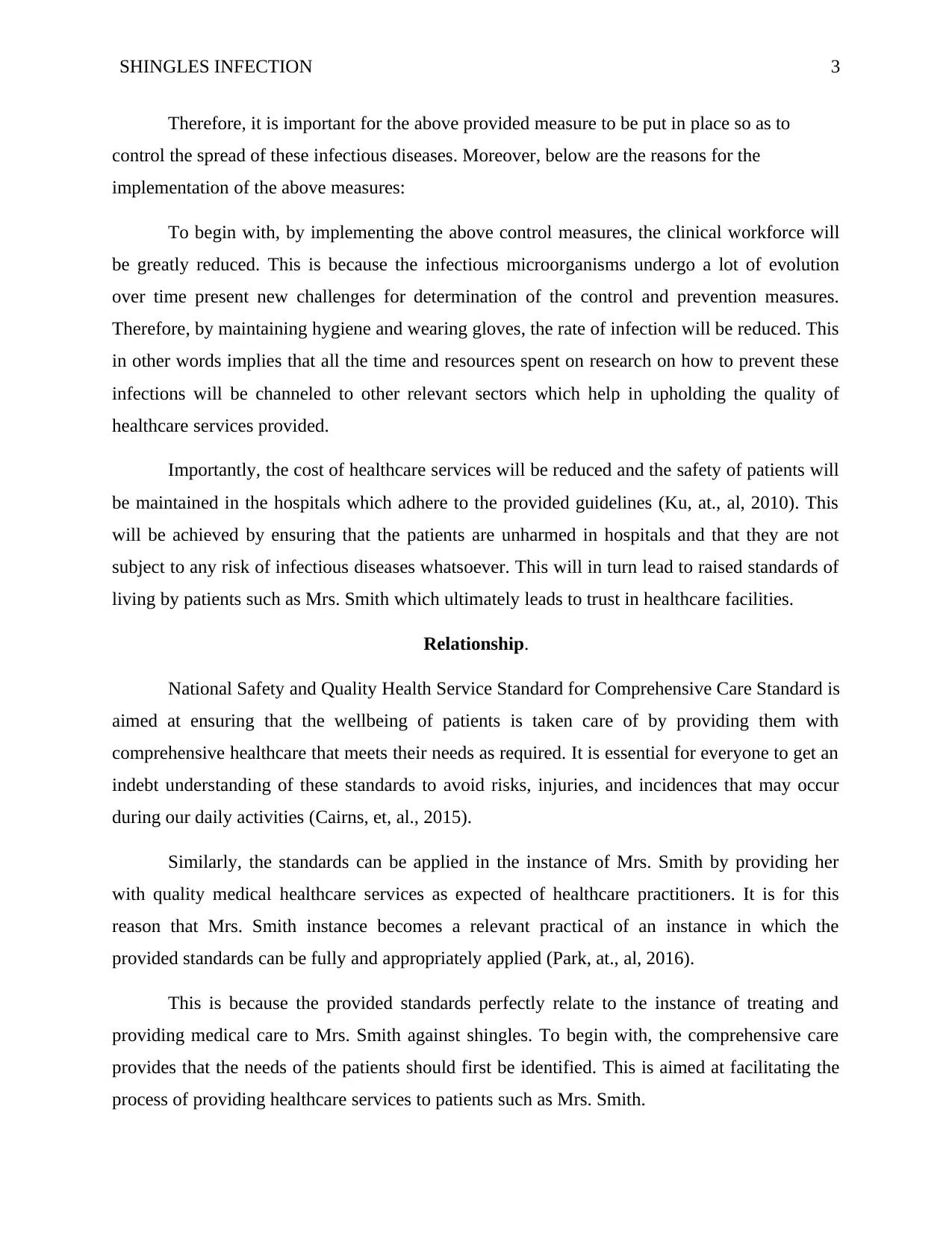
SHINGLES INFECTION 3
Therefore, it is important for the above provided measure to be put in place so as to
control the spread of these infectious diseases. Moreover, below are the reasons for the
implementation of the above measures:
To begin with, by implementing the above control measures, the clinical workforce will
be greatly reduced. This is because the infectious microorganisms undergo a lot of evolution
over time present new challenges for determination of the control and prevention measures.
Therefore, by maintaining hygiene and wearing gloves, the rate of infection will be reduced. This
in other words implies that all the time and resources spent on research on how to prevent these
infections will be channeled to other relevant sectors which help in upholding the quality of
healthcare services provided.
Importantly, the cost of healthcare services will be reduced and the safety of patients will
be maintained in the hospitals which adhere to the provided guidelines (Ku, at., al, 2010). This
will be achieved by ensuring that the patients are unharmed in hospitals and that they are not
subject to any risk of infectious diseases whatsoever. This will in turn lead to raised standards of
living by patients such as Mrs. Smith which ultimately leads to trust in healthcare facilities.
Relationship.
National Safety and Quality Health Service Standard for Comprehensive Care Standard is
aimed at ensuring that the wellbeing of patients is taken care of by providing them with
comprehensive healthcare that meets their needs as required. It is essential for everyone to get an
indebt understanding of these standards to avoid risks, injuries, and incidences that may occur
during our daily activities (Cairns, et, al., 2015).
Similarly, the standards can be applied in the instance of Mrs. Smith by providing her
with quality medical healthcare services as expected of healthcare practitioners. It is for this
reason that Mrs. Smith instance becomes a relevant practical of an instance in which the
provided standards can be fully and appropriately applied (Park, at., al, 2016).
This is because the provided standards perfectly relate to the instance of treating and
providing medical care to Mrs. Smith against shingles. To begin with, the comprehensive care
provides that the needs of the patients should first be identified. This is aimed at facilitating the
process of providing healthcare services to patients such as Mrs. Smith.
Therefore, it is important for the above provided measure to be put in place so as to
control the spread of these infectious diseases. Moreover, below are the reasons for the
implementation of the above measures:
To begin with, by implementing the above control measures, the clinical workforce will
be greatly reduced. This is because the infectious microorganisms undergo a lot of evolution
over time present new challenges for determination of the control and prevention measures.
Therefore, by maintaining hygiene and wearing gloves, the rate of infection will be reduced. This
in other words implies that all the time and resources spent on research on how to prevent these
infections will be channeled to other relevant sectors which help in upholding the quality of
healthcare services provided.
Importantly, the cost of healthcare services will be reduced and the safety of patients will
be maintained in the hospitals which adhere to the provided guidelines (Ku, at., al, 2010). This
will be achieved by ensuring that the patients are unharmed in hospitals and that they are not
subject to any risk of infectious diseases whatsoever. This will in turn lead to raised standards of
living by patients such as Mrs. Smith which ultimately leads to trust in healthcare facilities.
Relationship.
National Safety and Quality Health Service Standard for Comprehensive Care Standard is
aimed at ensuring that the wellbeing of patients is taken care of by providing them with
comprehensive healthcare that meets their needs as required. It is essential for everyone to get an
indebt understanding of these standards to avoid risks, injuries, and incidences that may occur
during our daily activities (Cairns, et, al., 2015).
Similarly, the standards can be applied in the instance of Mrs. Smith by providing her
with quality medical healthcare services as expected of healthcare practitioners. It is for this
reason that Mrs. Smith instance becomes a relevant practical of an instance in which the
provided standards can be fully and appropriately applied (Park, at., al, 2016).
This is because the provided standards perfectly relate to the instance of treating and
providing medical care to Mrs. Smith against shingles. To begin with, the comprehensive care
provides that the needs of the patients should first be identified. This is aimed at facilitating the
process of providing healthcare services to patients such as Mrs. Smith.
⊘ This is a preview!⊘
Do you want full access?
Subscribe today to unlock all pages.

Trusted by 1+ million students worldwide
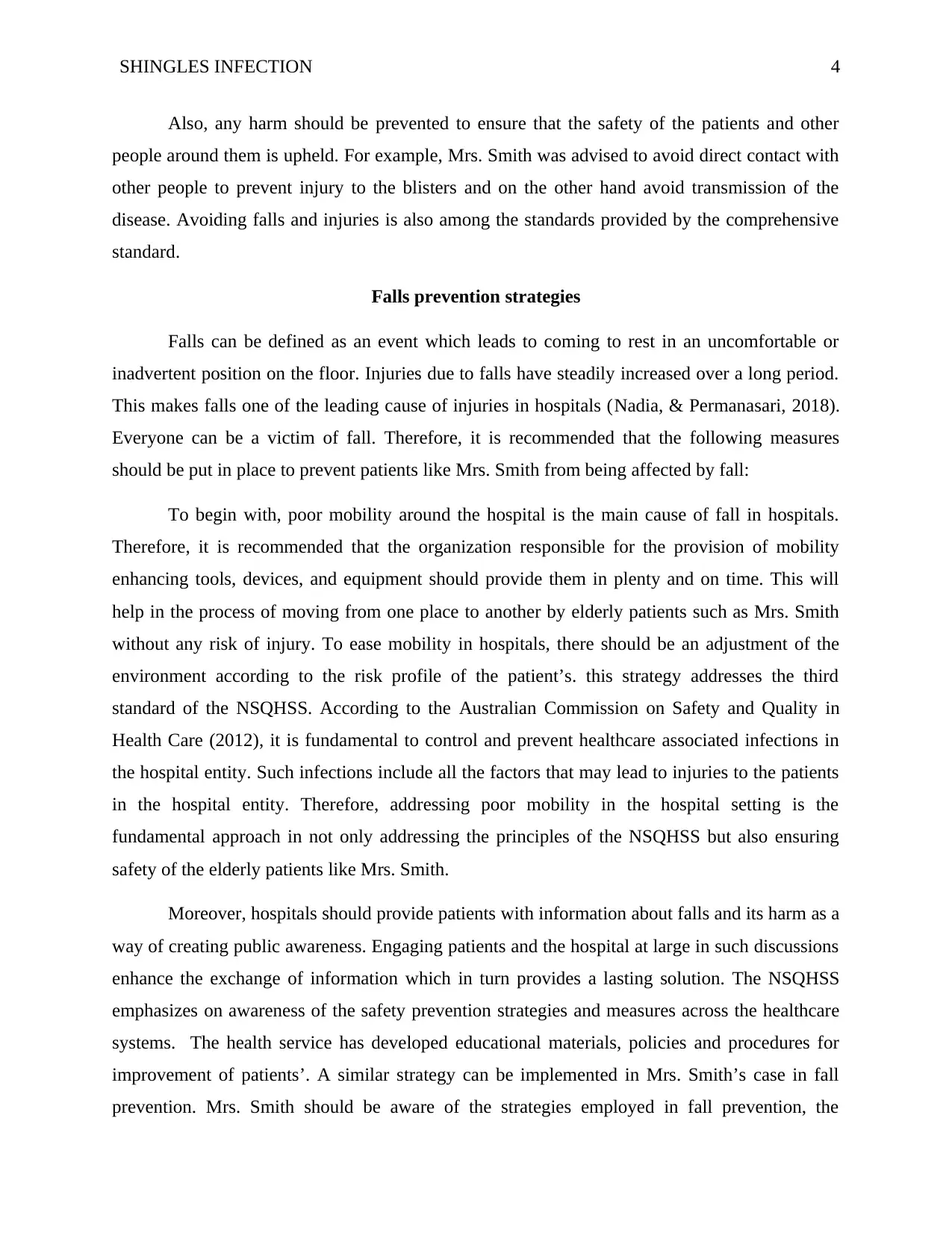
SHINGLES INFECTION 4
Also, any harm should be prevented to ensure that the safety of the patients and other
people around them is upheld. For example, Mrs. Smith was advised to avoid direct contact with
other people to prevent injury to the blisters and on the other hand avoid transmission of the
disease. Avoiding falls and injuries is also among the standards provided by the comprehensive
standard.
Falls prevention strategies
Falls can be defined as an event which leads to coming to rest in an uncomfortable or
inadvertent position on the floor. Injuries due to falls have steadily increased over a long period.
This makes falls one of the leading cause of injuries in hospitals (Nadia, & Permanasari, 2018).
Everyone can be a victim of fall. Therefore, it is recommended that the following measures
should be put in place to prevent patients like Mrs. Smith from being affected by fall:
To begin with, poor mobility around the hospital is the main cause of fall in hospitals.
Therefore, it is recommended that the organization responsible for the provision of mobility
enhancing tools, devices, and equipment should provide them in plenty and on time. This will
help in the process of moving from one place to another by elderly patients such as Mrs. Smith
without any risk of injury. To ease mobility in hospitals, there should be an adjustment of the
environment according to the risk profile of the patient’s. this strategy addresses the third
standard of the NSQHSS. According to the Australian Commission on Safety and Quality in
Health Care (2012), it is fundamental to control and prevent healthcare associated infections in
the hospital entity. Such infections include all the factors that may lead to injuries to the patients
in the hospital entity. Therefore, addressing poor mobility in the hospital setting is the
fundamental approach in not only addressing the principles of the NSQHSS but also ensuring
safety of the elderly patients like Mrs. Smith.
Moreover, hospitals should provide patients with information about falls and its harm as a
way of creating public awareness. Engaging patients and the hospital at large in such discussions
enhance the exchange of information which in turn provides a lasting solution. The NSQHSS
emphasizes on awareness of the safety prevention strategies and measures across the healthcare
systems. The health service has developed educational materials, policies and procedures for
improvement of patients’. A similar strategy can be implemented in Mrs. Smith’s case in fall
prevention. Mrs. Smith should be aware of the strategies employed in fall prevention, the
Also, any harm should be prevented to ensure that the safety of the patients and other
people around them is upheld. For example, Mrs. Smith was advised to avoid direct contact with
other people to prevent injury to the blisters and on the other hand avoid transmission of the
disease. Avoiding falls and injuries is also among the standards provided by the comprehensive
standard.
Falls prevention strategies
Falls can be defined as an event which leads to coming to rest in an uncomfortable or
inadvertent position on the floor. Injuries due to falls have steadily increased over a long period.
This makes falls one of the leading cause of injuries in hospitals (Nadia, & Permanasari, 2018).
Everyone can be a victim of fall. Therefore, it is recommended that the following measures
should be put in place to prevent patients like Mrs. Smith from being affected by fall:
To begin with, poor mobility around the hospital is the main cause of fall in hospitals.
Therefore, it is recommended that the organization responsible for the provision of mobility
enhancing tools, devices, and equipment should provide them in plenty and on time. This will
help in the process of moving from one place to another by elderly patients such as Mrs. Smith
without any risk of injury. To ease mobility in hospitals, there should be an adjustment of the
environment according to the risk profile of the patient’s. this strategy addresses the third
standard of the NSQHSS. According to the Australian Commission on Safety and Quality in
Health Care (2012), it is fundamental to control and prevent healthcare associated infections in
the hospital entity. Such infections include all the factors that may lead to injuries to the patients
in the hospital entity. Therefore, addressing poor mobility in the hospital setting is the
fundamental approach in not only addressing the principles of the NSQHSS but also ensuring
safety of the elderly patients like Mrs. Smith.
Moreover, hospitals should provide patients with information about falls and its harm as a
way of creating public awareness. Engaging patients and the hospital at large in such discussions
enhance the exchange of information which in turn provides a lasting solution. The NSQHSS
emphasizes on awareness of the safety prevention strategies and measures across the healthcare
systems. The health service has developed educational materials, policies and procedures for
improvement of patients’. A similar strategy can be implemented in Mrs. Smith’s case in fall
prevention. Mrs. Smith should be aware of the strategies employed in fall prevention, the
Paraphrase This Document
Need a fresh take? Get an instant paraphrase of this document with our AI Paraphraser
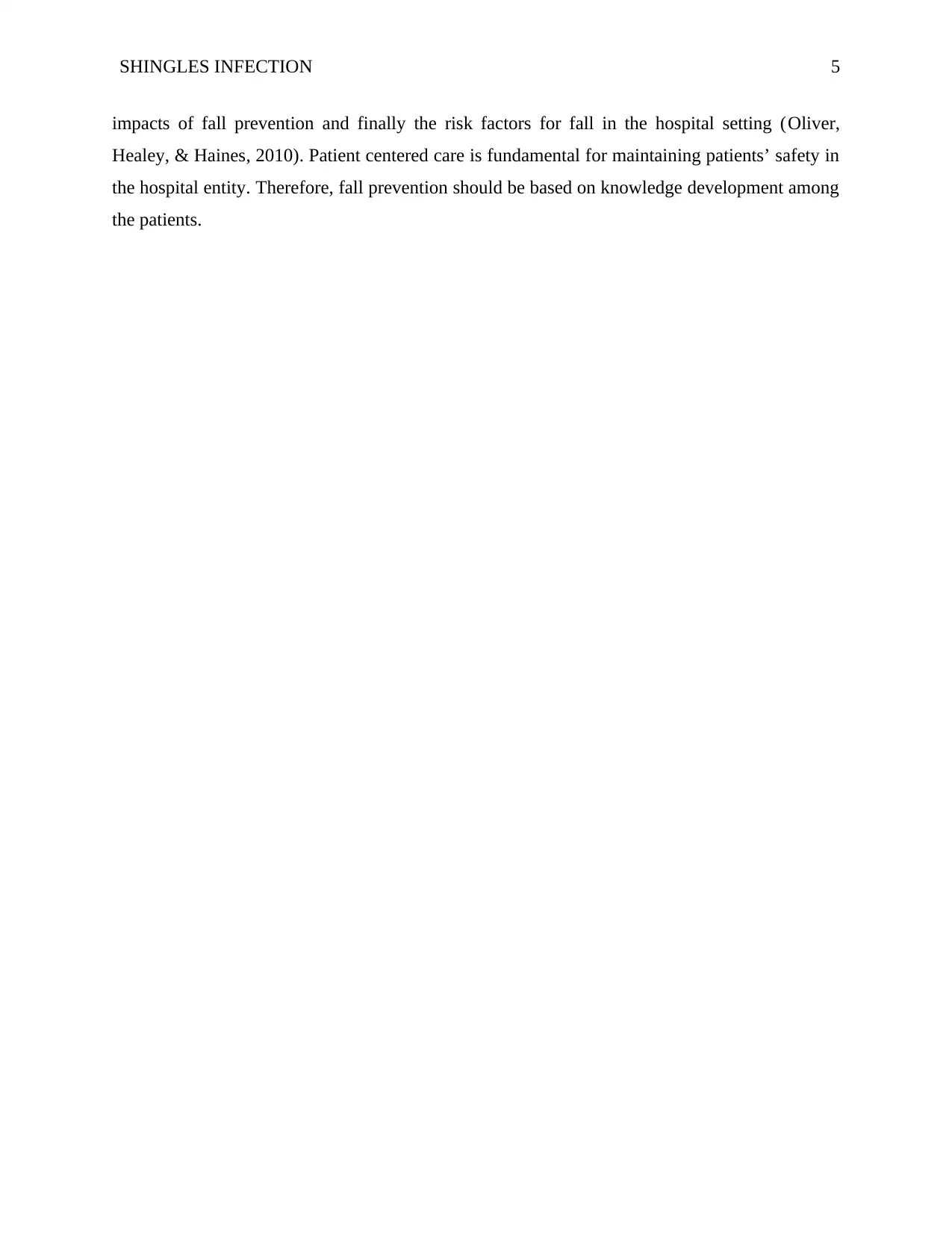
SHINGLES INFECTION 5
impacts of fall prevention and finally the risk factors for fall in the hospital setting (Oliver,
Healey, & Haines, 2010). Patient centered care is fundamental for maintaining patients’ safety in
the hospital entity. Therefore, fall prevention should be based on knowledge development among
the patients.
impacts of fall prevention and finally the risk factors for fall in the hospital setting (Oliver,
Healey, & Haines, 2010). Patient centered care is fundamental for maintaining patients’ safety in
the hospital entity. Therefore, fall prevention should be based on knowledge development among
the patients.
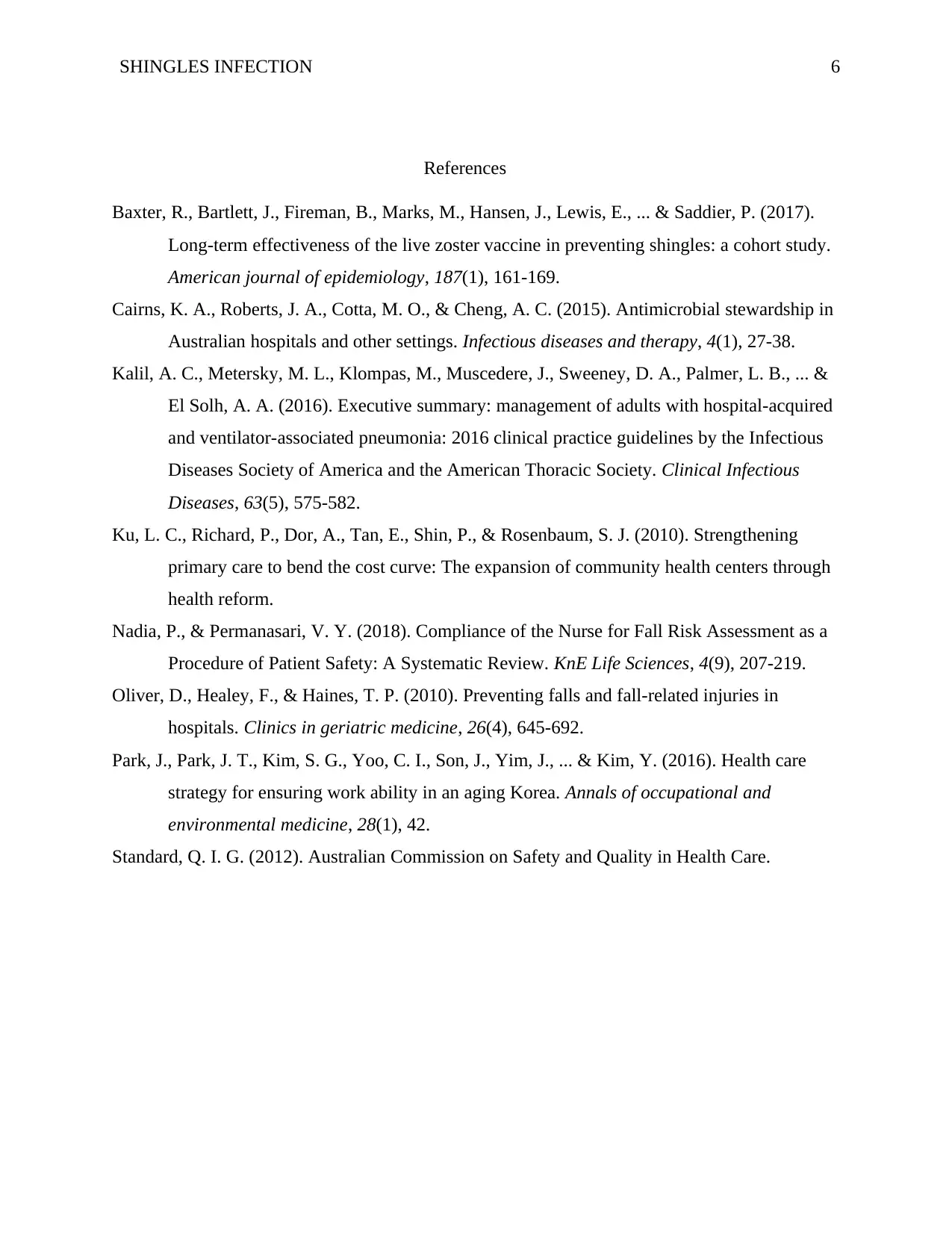
SHINGLES INFECTION 6
References
Baxter, R., Bartlett, J., Fireman, B., Marks, M., Hansen, J., Lewis, E., ... & Saddier, P. (2017).
Long-term effectiveness of the live zoster vaccine in preventing shingles: a cohort study.
American journal of epidemiology, 187(1), 161-169.
Cairns, K. A., Roberts, J. A., Cotta, M. O., & Cheng, A. C. (2015). Antimicrobial stewardship in
Australian hospitals and other settings. Infectious diseases and therapy, 4(1), 27-38.
Kalil, A. C., Metersky, M. L., Klompas, M., Muscedere, J., Sweeney, D. A., Palmer, L. B., ... &
El Solh, A. A. (2016). Executive summary: management of adults with hospital-acquired
and ventilator-associated pneumonia: 2016 clinical practice guidelines by the Infectious
Diseases Society of America and the American Thoracic Society. Clinical Infectious
Diseases, 63(5), 575-582.
Ku, L. C., Richard, P., Dor, A., Tan, E., Shin, P., & Rosenbaum, S. J. (2010). Strengthening
primary care to bend the cost curve: The expansion of community health centers through
health reform.
Nadia, P., & Permanasari, V. Y. (2018). Compliance of the Nurse for Fall Risk Assessment as a
Procedure of Patient Safety: A Systematic Review. KnE Life Sciences, 4(9), 207-219.
Oliver, D., Healey, F., & Haines, T. P. (2010). Preventing falls and fall-related injuries in
hospitals. Clinics in geriatric medicine, 26(4), 645-692.
Park, J., Park, J. T., Kim, S. G., Yoo, C. I., Son, J., Yim, J., ... & Kim, Y. (2016). Health care
strategy for ensuring work ability in an aging Korea. Annals of occupational and
environmental medicine, 28(1), 42.
Standard, Q. I. G. (2012). Australian Commission on Safety and Quality in Health Care.
References
Baxter, R., Bartlett, J., Fireman, B., Marks, M., Hansen, J., Lewis, E., ... & Saddier, P. (2017).
Long-term effectiveness of the live zoster vaccine in preventing shingles: a cohort study.
American journal of epidemiology, 187(1), 161-169.
Cairns, K. A., Roberts, J. A., Cotta, M. O., & Cheng, A. C. (2015). Antimicrobial stewardship in
Australian hospitals and other settings. Infectious diseases and therapy, 4(1), 27-38.
Kalil, A. C., Metersky, M. L., Klompas, M., Muscedere, J., Sweeney, D. A., Palmer, L. B., ... &
El Solh, A. A. (2016). Executive summary: management of adults with hospital-acquired
and ventilator-associated pneumonia: 2016 clinical practice guidelines by the Infectious
Diseases Society of America and the American Thoracic Society. Clinical Infectious
Diseases, 63(5), 575-582.
Ku, L. C., Richard, P., Dor, A., Tan, E., Shin, P., & Rosenbaum, S. J. (2010). Strengthening
primary care to bend the cost curve: The expansion of community health centers through
health reform.
Nadia, P., & Permanasari, V. Y. (2018). Compliance of the Nurse for Fall Risk Assessment as a
Procedure of Patient Safety: A Systematic Review. KnE Life Sciences, 4(9), 207-219.
Oliver, D., Healey, F., & Haines, T. P. (2010). Preventing falls and fall-related injuries in
hospitals. Clinics in geriatric medicine, 26(4), 645-692.
Park, J., Park, J. T., Kim, S. G., Yoo, C. I., Son, J., Yim, J., ... & Kim, Y. (2016). Health care
strategy for ensuring work ability in an aging Korea. Annals of occupational and
environmental medicine, 28(1), 42.
Standard, Q. I. G. (2012). Australian Commission on Safety and Quality in Health Care.
⊘ This is a preview!⊘
Do you want full access?
Subscribe today to unlock all pages.

Trusted by 1+ million students worldwide
1 out of 6
Related Documents
Your All-in-One AI-Powered Toolkit for Academic Success.
+13062052269
info@desklib.com
Available 24*7 on WhatsApp / Email
![[object Object]](/_next/static/media/star-bottom.7253800d.svg)
Unlock your academic potential
Copyright © 2020–2025 A2Z Services. All Rights Reserved. Developed and managed by ZUCOL.




